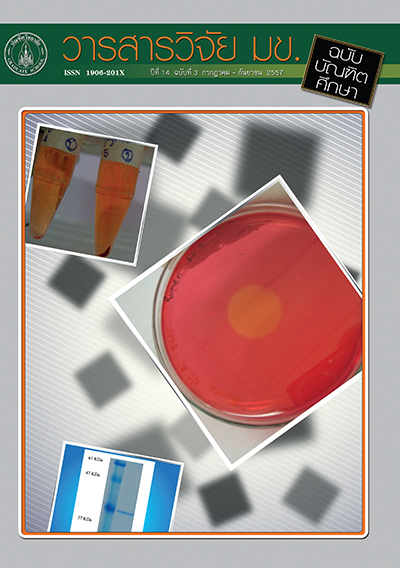การปนเปื้อนจุลินทรีย์และมาตรฐานของผลิตภัณฑ์เสริมอาหารที่ บริโภคในครัวเรือน กรณีศึกษาเทศบาลตำบลท่าพระ อำเภอเมือง จังหวัดขอนแก่น
Keywords:
Dietary supplement product(ผลิตภัณฑ์เสริมอาหาร), Label(ฉลาก), Standard of dietary supplement product(มาตรฐานของผลิตภัณฑ์เสริมอาหาร)Abstract
การวิจัยเชิงพรรณนาแบบภาคตัดขวางครั้งนี้ มีวัตถุประสงค์เพื่อศึกษาการปนเปื้อนเชื้อรา เชื้อ Escherichia coli และมาตรฐานด้านฉลากในผลิตภัณฑ์เสริมอาหารที่บริโภคในครัวเรือน ในเขตเทศบาลตำบล ท่าพระ อำเภอเมือง จังหวัดขอนแก่น จำนวน 377 ตัวอย่าง โดยใช้แบบสำรวจมาตรฐานด้านฉลากตามเกณฑ์ ผลิตภัณฑ์เสริมอาหาร ของคณะกรรมการอาหารและยา ตรวจการปนเปื้อนเชื้อรา โดยวิธี Bacteriological Analytical Manual และตรวจการปนเปื้อนเชื้อ Escherichia coli โดยวิธี Most probable number วิเคราะห์ข้อมูลโดยใช้สถิติ ค่าความถี่ ร้อยละ ค่าเฉลี่ยและส่วนเบี่ยงเบนมาตรฐาน ผลการศึกษาพบว่าผลิตภัณฑ์ เสริมอาหารที่บริโภคในครัวเรือนในเขตเทศบาลตำบลท่าพระไม่ได้มาตรฐานด้านฉลาก ร้อยละ 31.55 ไม่มี ฉลาก ร้อยละ 22.01โดยผลิตภัณฑ์เสริมอาหารที่ไม่ได้มาตรฐานด้านฉลาก พบการปนเปื้อนเชื้อรา ร้อยละ 13.44 พบการปนเปื้อนเชื้อ Escherichia coli > 3 MPN/กรัมอาหาร ร้อยละ 40.33 ส่วนผลิตภัณฑ์เสริมอาหารที่ ไม่มีฉลาก พบการปนเปื้อนเชื้อรา ร้อยละ 67.47 และพบการปนเปื้อนเชื้อ Escherichia coli > 3 MPN/กรัม อาหาร ร้อยละ 84.34 ตามลำดับ
The cross – sectional descriptive study was performed in order to evaluate the contamination of mold, Escherichia coli, and the packaging label standards of household dietary supplement products consumed in Municipal of Thapra, Muang District, Khon Kaen Province. The 377 samples of dietary supplement products were randomly selected. Study tools were consisted of survey forms previously described by the Food and Drug Administration. , Mold detection was performed using bacteriological analytical manual method. The most probable number was used to detect Escherichia coli in dietary supplement products. The statistical frequency, percentages and mean ± standard deviations were used to achieve the statistical analysis. The results showed that dietary supplements without appropriate labels were 31.55% and the dietary supplement products without product labeling were 22.01%. contamination in inappropriate labeling dietary supplement products and non-labeling dietary supplement products were 13.44% and 67.47%, respectively. The contamination of >3 MPN/grams Escherichia coli inappropriate labeling dietary supplement products and non-labeling dietary supplement products were 40.33% and 84.34%, respectively.



